Page 1
Daily News
By Gail Helmer
| Send Us News | Archives | Main |
Tuesday, January 28, 2003
- Aces High II: Tour of Duty
- Fighting Steel Project v8.0 Released
- Silent Hunter II and Destyroyer Command Multiplayer Upgrade
- IL-2 Sturmovik Poll
- BF 1942 Girls of Rome Countdown
- Command & Conquer Renegade retail patches & server v1.037
- Avsim Announces Freeware Flight Group
- CFS Aircraft: A6M3 Model 32
- Stunning P-51 for Fly II Released
- ATI Sponsors Largest LAN Party in Northwest
- Pentium Price Cuts Approaching
- US, India Plan to Conduct Joint Air Combat Exercise
- WANTED: Air Force Experience
- U.S. Army: National Training Center and Opposing Force
- Award Means More Than Individual Recognition for Pilot
- Norway Agrees To Participation In Eurofighter Partnership
- Raytheon Awarded $39 Million for Maverick Missiles
- ATK Develops Precision-Guided Mid-Range Munition
- SGI Graphics Supercomputers to Power U.S. Air Force F-16 Pilot Training Systems
- Giant Shadow Experiment Tests New SSGN Capabilities
- NAVAIR Patuxent River to Host Second UAV Flight Demonstration
- Pilot Survives U-2 Crash, Recovery Continues
PC Game & Hardware News
Aces High II: Tour of Duty
(GRAPEVINE, TX) HiTech Creations, producer of the award winning online combat simulation Aces High, has announced plans to launch the next generation of the game, Aces High II: Tour of Duty, in Q3 2003. Aces High is the most popular massively multiplayer online flight simulator on the market, with players from over 50 countries worldwide participating in virtual combat 24 hours a day.
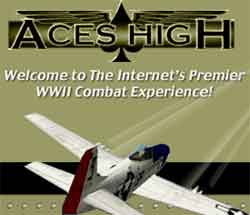
Aces High announces a complete overhaul of the game
Aces High II will follow-up on the award-winning Aces High with new graphics, terrain, physics, damage, interface, and a host of other improvements. Online play will be divided between servers running Aces High Classic - fast paced arenas with an emphasis on player vs. player combat - and the revolutionary new Tour of Duty.
Tour of Duty will bring to life a new online world that combines combat simulation and military role-playing in a historical World War II setting. In this structured environment, players create a persistent character who will follow a career path with either the Axis or Allies through the course of the war. These characters will be expressed through custom avatars and will receive promotions and medals, or demotions and even court-martials based upon their performance at completing assigned missions. Tour of Duty will reward both cooperative and competitive play.
"Aces High was originally launched in 2000 and since then we've made tremendous improvements and additions through 11 updates," says company CEO, Dale Addink. "It's now time for us to put our efforts into the 2nd generation of Aces High. Our goal is not just to improve the look and feel of the game but also to appeal to a wider audience. Tour of Duty will attract people who are looking for more than an online dogfight and want to take on the role of being a combat pilot in WWII."
Further information about Aces High and the upcoming Aces High II: Tour of Duty can be found at http://www.flyaceshigh.com.
Website: Hi-Tech Creations
Fighting Steel Project v8.0 Released
Naval Warfare Simulations - Fighting Steel Project v8.0 has been posted. Five new ship classes including the USN CL Cleveland, RM CA Trento, RM CA Zara, RM DD Turbine, and RM DD Sauro. Lots of new features and updates including improved radar gunnery, efficiency enhancements in the code, visibility and illumination improvements, detailed combat log, various improvements to the gunnery combat, better AI tactical decisions, various damage effects corrections, and much more! For more information, see site listed below:
Website: Naval Warfare Simulations
Silent Hunter II and Destyroyer Command Multiplayer Upgrade
Here's the latest:In addition to upgrading the multiplayer components, Subsim Review's Projekt Messerwetzer has fixed some features and added others. We have tweaked certain elements of the sims that greatly improve gameplay, as well. The games are better and more realistically balanced now. Now Silent Hunter II and Destroyer Command players can look forward to these new features.Download: Projekt Messerwetzer
- Maximum number of players increased from 4 to 10
- Larger AI convoys, up to 30 ships
- DDs get HF/DF contacts if the sub players talk on TEAM, but the contacts fade over time and do not follow the sub.
- Silent running is now working and reduces detectability of U-Boat by 50% under certain conditions. A sub can go into silent running and make it very difficult for a DD player to find him. Of course, the sub isn't going anywhere at 2 knots! And he cannot reload torpedoes or effect repairs in SR.
- A DD can elect to go ALL Stop and listen--it improves the chances of getting an acoustic contact. However, he's a big fat target to a U-boat, sitting all pretty and still in the water.
- Subs that are picked up on sonar are marked on the map but there is an indefinite margin of uncertainty on the contact. He may be right where the mark is, ... or me may be 500 yards to one side... you never know for certain.
- Players can now drop Map Notes that only their side can see.
- DDs can now lay down smoke!! It's just eye candy but it sure adds to the feel.
- Resupply feature working (with supported scenarios)
- Manual dive planes are now functional. Player can change depth more rapidly but it comes with a price--if the player is not careful he can exceed crush depth or breech.
- Enhanced time compression--now up to 128x allowed.
- Peer-to-peer system, meaning if host disconnects, game continues with another player automatically enabled as the new host
- Periscope is automatically lowered at 40 meters or deeper and cannot be raised until U-boat is at a depth of 40 meters or less.
- Torpedo camera is disabled when external view is disabled in the MP realism settings.
- Damage to ships may grow worse over time, as in real life this happens to all units in the game, including the player’s ship.
- Secondary explosions are now enabled.
- Magazine explosions are now enabled.
- If game is paused by a player who quits or is disconnected, remaining players can now unpause the game and continue to play.
- Torpedoes are now armed at the appropriate times and ranges originally set in the game code.
- Deck Gun and AA gun stations are unavailable during heavy seas or when running with decks awash.
- When a DD goes to All Stop, he fades from the sub's sonar!
Future Planned Enhancements: This is the final release of Projekt Messerwetzer Phase I. Additional refinements and features will be implemented in PM Phase II. If there is enough support from the community, Phase II will begin in February. We hope to include things such as better torpedo detection, functional DD smokescreens, excessive depth angle damage incursion, more realistic manual TDC, minefields, anti-submarine nets, BOLDS, realistic depth degradation at All Stop, forward-firing hedgehogs, and more. We are also examining an Aces of the Deep style dynamic career campaign.
Website: Silent Hunter II Wolfpack League
IL-2 Sturmovik Poll
Cartrix has posted the results of the IL2Sturmovik.com poll asking whether readers had a pilot's license:Question: Do you have a pilot's license?
No - 4289 votes (69.5%)
Yes - 1882 votes (30.5%)
Total Votes: 6171
They are running a new poll: "How often do you visit the IL-2 forums?"
Website: IL-2Sturmovik.com
BF 1942 Girls of Rome Countdown
Hey, if you are going to have a countdown, you might as well have fun doing it, right?
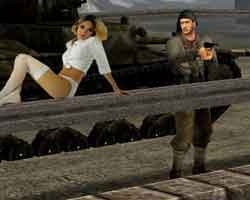
Er, can I interest you in some chocolate or nyl...oh, you have a pair already.
From their website:The Road to Rome countdown has begun, only a few days away! To celebrate, everyday we will feature a new "Girls of Rome" picture for all to enjoy. Hopefully they will make the wait a little bit more bearable. Also, be sure to stop by our Road to Rome section. It's the biggest and best around, enjoy!Website: PlanetBattlefield
Command & Conquer Renegade Retail Patches & Server v1.037
3DGamers is hosting the latest patch and server for Command & Conquer: Renegade.
Press Release Info: Command & Conquer: Renegade is a fast-paced 3-D action game set in the gripping Command & Conquer universe. For the first time, experience the Command and Conquer universe up close and personal as you fight it out on the ground among the structures, vehicles and weapons made famous in the original C&C. You assume the role of Havoc, elite GDI commando who fights and explores from a first or third-person viewpoint. Battling through exotic indoor and outdoor environments, you're free to use both brute force and stealth in your mission objectives against the evil Brotherhood of Nod.
Download: 3D Gamers
Freeware Flight Group, New CFS Aircraft, P-51 for Fly II
As posted on the AVSIM website:Website: AVSIM
- New FFG Website
Posted: Tuesday, January 28, 2003 - 16:48
Steve Reyling reports that The Freeware Flight Group's new website in now online. Steve comments, "Please feel free to visit at www.avsim.com/ffg. FFG also asks for your assistance by reporting any broken links or other issues in the FFG forum."
- CFS Aircraft: A6M3 Model 32 "Hamp"
A6M3 Model 32 "Hamp" by Gerald Lindell, George Lindell, Andrew van Duin & Lobo da Silva
- Stunning P-51 for Fly II Released
Posted: Tuesday, January 28, 2003 - 0:38
Reader Bert Pieke notes in Avsim's Screen Shots Forum that "A milestone aircraft for Fly II was just released (from Laurent Claudet, Jean Sabatier, and TJ) by the French group ROTW (available here in the Avsim library). The quality of the aircraft, inside and out, and the accompanying documentation would compare favorably with the very best payware aircraft for Fly or FS2k2."
To wet your appetite, see Johnny Svensson's message for some shots from the ROTW site here. Bert adds, "Note that the ailerons move realistically in the side cockpit view, just one of many details... not to mention the cockpit graphics that are some of the best I've seen in a civilian or combat simulator."
ATI Sponsors Largest Lan Party in Northwest
(MARKHAM, Ontario) — ATI Technologies Inc. today announced that it is the title sponsor of GDFest, one of the largest LAN party events held on the West Coast. In addition to its sponsorship, ATI will be giving away 10 RADEON 9700 PRO graphics boards to gamers at GDFest.
“ATI’s RADEON 9700 PRO is the card of choice for gamers” said Paul Ayscough, Director, Corporate Marketing, ATI Technologies Inc. “Our continuing support and involvement in gaming events like GDFest allows us to put the world’s best graphics into the hands of more gaming enthusiasts.”
“It makes perfect sense for one of the biggest and best gaming events to be sponsored by ATI —the king of the graphics industry,” said Duane Pemberton, Publisher, Gamer’s Depot. “ATI’s RADEON 9700 PRO is by far the best graphics board on the market, and we’re thrilled to have ATI as the title sponsor for GDFest 2003.”
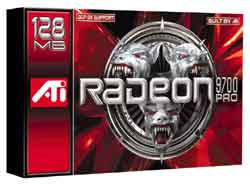
RADEON 9700 PRO chosen to power hundreds of gamers at GDFest
At GDFest, gamers will compete against one-another on high-end gaming machines powered by the RADEON 9700 PRO. Winners of the tournaments will be awarded various hardware components, and every registrant will have the chance to win a RADEON 9700 PRO through regular door prize draws.
ATI’s RADEON 9700 PRO, the world’s first visual processing unit (VPU), delivers 3D graphics at unparalleled speed. With a 256-bit memory interface and industry-leading support of Microsoft DirectX 9.0, the RADEON 9700 PRO puts cinematic-quality real time graphics in the hands of gamers.
GDFest will run from 10:00 AM until 10:00 PM on February 1, 2003. Registration and further details can be found at their website:
Website: GDFest Website: ATI
Pentium Price Cuts Approaching
By John G. Spooner
Staff Writer, CNET News.com
Intel will pull out its scissors next month to make the first of two price cuts scheduled for this quarter, sources say. The chipmaker has planned the price adjustment for desktop Pentium 4 chips for late February, according to sources. It will be the first such cut for these chips since November.
The price cuts for the desktop chips, including the top-of-the-line 3.06GHz Pentium 4, will range from about $25 to $50, sources said
Full Story: CNET News.com
Defense & Aerospace News
US, India Plan to Conduct Joint Air Combat Exercise
(PTI)— In a sign of intensifying defence cooperation, the US and Indian Air Forces are planning to conduct their first joint exercise with fighter aircraft later this year or in early 2004, American officials have said.
"We are still in the early planning stages of this exercise," said Major James Law, a spokesman for the US Air Force's headquarters for Pacific operations.
The US has asked that India fly its top-of-the-line warplanes rather than the older MiG-29s that India also owns, because the US Air Force has never had the opportunity to exercise against the Su-30 or its variant, the Su-27, he said.
Full Story: The Hindu
WANTED: Air Force Experience
The Air Force Retention Office (AFRO) is teaming up with Canadian Forces Recruiting Group (CFRG) to get the word out that the Air Force is actively seeking fully trained ex-military pilots and technicians who may be considering re-enrolling.
The AFRO, which is based in Ottawa, was created in August 2002 to identify and staff initiatives aimed at improving the retention of Air Force personnel.
Due to manning shortages, former Pilots, Avionics System Technicians (AVS Tech), Aviation Systems Technicians (AVN Tech) and Aircraft Structure Technicians (ACS Tech) are currently being sought-out by the AFRO.
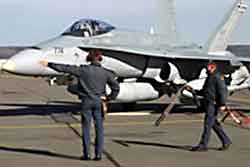
Photo by Sgt Denis Mah, DGPA/J5PA2 Combat Camera
Re-enrollment for previous serving members can take as long as one year. The AFRO is working closely with CFRG and the career managers in an effort to reduce re-enrollment waiting time to four to six weeks.
Former AVS Tech may be eligible for a $20,000 recruitment allowance if they meet the criteria described in CANFORGEN 113/02 220930Z OCT 01. Recruitment allowances are not available for Pilots, AVN and ACS Techs.
The AFRO considers those returning as “force multipliers”. There are many advantages to re-enrolling fully qualified personnel. First, tremendous savings are achieved by cutting down on the cost of training. Considering that it can cost over $5 million and take five to six years to train a new pilot, re-enrolling is financially sound and allows us to capitalize on a former investment. The same is true for technicians where it can take up to 4 years to train to a journeyman level. Secondly, re-enrolling qualified personnel increases the experience pool that can be tapped into in order to regenerate. Finally, those returning to the CF are an indicator to serving personnel that the Air Force remains an employer of choice.
Persons interested in receiving more information on this initiative are asked to contact the AFRO through one of its toll free numbers.
For pilot re-enrollment please contact Captain Lee Williams at 1-877-877-2741. Those seeking more insight into re-enrolling into the MOC 500 occupations can refer their queries to Master Warrant Officer Bob Ellement at 1-866-355-8195.
U.S. Army: National Training Center and Opposing Force
(FORT IRWIN, Calif.) In order to train America's soldiers for global conflicts in the Middle East and Central Asia, the U.S. Army operates extensive war game training exercises to simulate real world combat and ensure U.S. military preparedness in the 21st century. While these exercises take place on a continuing basis at Army installations throughout the world, the Army operates the National Training Center (NTC), based in the Mojave Desert, at Fort Irwin, Calif., to prepare Army units for an ever- increasing range of hostile conditions.
Activated in 1981 with more than 1 million soldiers trained, the NTC is the Army's premier combat training installation in the world. This desert environment allows visiting Army units to sharpen their skills and focus by fighting NTC's resident Opposing Force (OPFOR), officially the 11th Armored Cavalry Regiment.
The OPFOR, one of the world's elite military training units, prepares the visiting brigades by simulating the tactics, appearance and strategies of America's enemies in a desert-based war game. Their mission is to prepare Army units in advance of deployment to global hot spots, by exposing soldiers to every element that would be present in a combat situation. These elements, which are present the very moment the rotational unit arrives at the NTC, include facing the challenges of guerilla warfare, chemical threats, close air attacks and civilians on the battlefield.
"OPFOR's mission is to make sure that every soldier is prepared for every possible combat situation, whether it be dealing with terrorist activities or biological warfare. We make sure that they're prepped and ready," said Col. Joe Moore, commander of the OPFOR. "The NTC helps units prevail against America's enemies and the harsh conditions that conceal them."
In addition to the actual war game, real-time instruction is another crucial aspect that helps drive the training experience for rotational units. A cadre of professional coaches observe and guide the exercises to maximize lessons learned. Called "observer controllers," these soldiers, who are experts and former participants in the NTC war games, observe unit performance and combat effectiveness while teaching, coaching and advising the unit leaders. In addition to this real-time instruction, NTC leaders also conduct daily after action reviews, which allow the unit personnel to break down the specific exercise of the day, and highlight the strengths and weaknesses of the mission. As always, training and improvement is the sole goal for these exercises.
"The most important goal for these rotations is that every soldier can improve upon their fundamental soldier skills and learn from their time spent at the NTC," added Moore. "The object of the battles out here is not winning or losing so much as it is learning from the battle. The real point is to train the visiting unit since they will be the one deployed into forward combat."
NTC war game exercises operate 10 times a year. They reemphasize the central principle that the U.S. Army, built on the strength of well-trained soldiers and state-of-the-art technology, is the most successful and powerful army in the world.
"It makes me proud to know that I'm helping train the Army through my work here at the NTC," said Capt. Josh Ekis, military intelligence officer, NTC. "Our role here is to make sure that no soldier goes into harm's way untrained."
Web site: National Training Center
IMAGE TEXT: A F U.S. ARMY LIVE-FIRE WAR GAME EXERCISES U.S. ARMY LIVE-FIRE WAR GAME EXERCISES Soldiers from the U.S. Army's 1st Cavalry Division at Ft. Hood, Texas, sharpen their skills during live-fire war game exercises at the National Training Center at Ft. Irwin, Calif. Based in the Mojave Desert, the National Training Center prepares and trains soldiers for future deployment to hostile situations throughout the world. (PRNewsFoto)[AS] FORT IRWIN, CA USA 01/27/2003
Award Means More Than Individual Recognition for Pilot
LEMOORE, Calif. (NNS) — One of the most visibly impressive marks of a military career is a chest full of medals.
Awards embody military tradition, signifying places, battles, competence and bravery. To honor actions above and beyond the call of duty in aerial combat, the Navy presents the Distinguished Flying Cross.
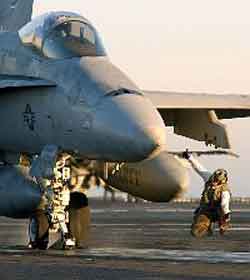
Official U.S. Navy file photo of a "trouble shooter" giving the final thumbs-up before an F/A-18C Hornet launches from USS Theodore Roosevelt (CVN 71). Lt. Andrew Hayes recently received the Distinguished Flying Cross to honor actions above and beyond the call of duty in aerial combat while embarked aboard TR in support of Operation Enduring Freedom.
For Distinguished Flying Cross recipient Lt. Andrew P. Hayes of Elgin, Ill., the rewards of performing honorably go beyond the medal he wears on his uniform.
"A lot of it has to do with being in the right place at the right time," said Hayes. "A lot of guys in my squadron would have done the same thing if they were in the same place I was."
On what began as a routine flight one night, Hayes’ aircraft launched from the aircraft carrier USS Theodore Roosevelt (CVN 71). The Roosevelt battle group was underway in the North Arabian Sea, supporting coalition efforts in Afghanistan.
It seemed as if an uneventful mission lay ahead. Things changed, however, when Hayes spotted a large mass of Taliban tanks and other armored vehicles three kilometers from a U.S. special operations unit.
Hayes knew he had to do something to protect the U.S. troops' position. When he directed his attacks, he chose the flank closest to the friendly troops, driving the enemy away.
Although fuel was low and he was under enemy anti-aircraft and small arms fire, Hayes continued to direct attacks and track the enemy’s position.
Six hours later, with the mission completed, 25 tanks and armored vehicles lay destroyed and enemy ground forces had been routed away, crippling the Taliban's ability to attack.
"The bigger accomplishment was saving American lives on the ground. It was Americans helping Americans. It was my job to make sure they were safe while they continued their mission," Hayes said.
One year later, he is now with the "Flying Eagles" of Fighter Attack Squadron (VFA) 122, based in Lemoore, Calif. He is an instructor now, and his award is more than a personal achievement. It serves as a model of inspiration for students who will one day "be in the right place at the right time."
"While the Distinguished Flying Cross is an award for individual courage, and this recognition is important, it is the effect it has on the morale of the pilots and other aircraft personnel that I appreciate the most," said Hayes.
The award has only been given to a handful of pilots in the war on Afghanistan. But to Hayes, the Distinguished Flying Cross does not represent his own personal valor, because he was not alone. He says it is about the guys on the ground. They are the ones who were "truly in harm’s way."
Hayes said, "At the end of the day, I go to a comfortable room and a shower. But the guys on the ground are without comfort when they perform their service to their country."
Norway Agrees to Participation in Eurofighter Partnership
(Hallbergmoos) -- The Royal Norwegian Ministry of Defence (MoD) and Eurofighter GmbH signed an agreement today that will involve Norwegian industry in the further development of the Eurofighter Typhoon Weapon System. Norway is the first country to formally participate in the Eurofighter industrial partnership for enhanced versions of the weapon system.
The agreement covers industrial participation in the Eurofighter programme that will be jointly funded by the Royal Norwegian MoD and Norwegian industry. Areas of particular interest include high technology development work in weapon systems integration, sensors - including radar, and flight controls. The initial contract is valued at €20 Million.
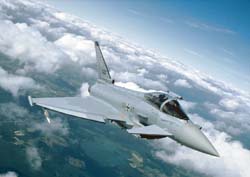
Norway to participate in Eurofighter development
Commenting on the agreement Filippo Bagnato, Chief Executive Officer, Eurofighter GmbH said: “We consider this agreement as a positive signal from the Norwegian Government that the choice of a replacement fighter has not been decided and that a competitive situation exists. The Eurofighter industry and nations will now work closely with Norway to demonstrate the strength and effectiveness of our partnership to deliver long-term benefits to the Norwegian Government and provide Norwegian industry with high technology work and jobs for its skilled labour force.”
Eurofighter Typhoon will formally enter service with the partner countries in 2003 and will be the mainstay of NATO air power for at least 30 years.
Under the partnership arrangement Norwegian companies will benefit from high technology work across the defence and aerospace spectrum. In particular this agreement will open the possibility of additional work within other programmes of the Eurofighter Partner Companies Alenia Aeronautica, BAE SYSTEMS, and EADS.
Raytheon Awarded $39 Million for Maverick Missiles
(TUCSON, Ariz.) The U.S. Air Force awarded Raytheon Company a $38.9 million Foreign Military Sales contract for Maverick missiles.
The FMS contract includes AGM-65 infrared (IR) Maverick missiles, trainers and associated spares for Taiwan, United Arab Emirates, Oman and Bahrain.
"This is another major award for the Raytheon-U.S. Air Force Maverick team as we continue to provide our international partners with the proven air-to- ground precision engagement capability of the IR Maverick missile," said Ron Shields, Raytheon Maverick program director.
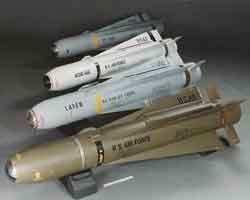
The AGM family of missiles
There are two versions of the IR Maverick missile: the AGM-65D and AGM-65G. The AGM-65D variant has an imaging infrared guidance system. The IR seeker presents a TV-like image on the cockpit display as it senses small differences in heat energy between that radiated by target objects and the surrounding background. The AGM-65D Maverick missile carries a 125-pound shaped charge warhead. The AGM-65G missile essentially uses the same guidance system with some software modifications that enables the missile to track larger targets. This variant carries the 300-pound blast fragmentation warhead with selected fuze delays.
Work is to be completed by December 2004 and will be performed primarily at Raytheon Missile Systems in Tucson, Ariz.
Maverick is a precision, air-to-ground missile that is used against small hard targets, armored vehicles, surface-to-air missile (SAM) sites, and high value targets, such as ships, port facilities and communications centers. The Maverick has launch-and-leave capability to enable the pilot to lock onto the target, launch the missile and then take evasive action.
ATK Awarded $21 Million Contract to Continue Development of Precision-Guided Mid-Range Munition
(MINNEAPOLIS) ATK (Alliant Techsystems) has been awarded a $21 million contract from the U.S. Army to continue development of the Army's new precision-guided Mid-Range Munition (MRM).
The contract represents the continuation of a multi-phased development program. The current phase will conclude in September with a gun-launched, guide-to-hit demonstration of MRM autonomous guidance. The next phase, system design and development, is expected to begin in 2004.
The kinetic-energy (KE) MRM projectile is designed to defeat a wide array of targets, including main battle tanks equipped with explosively reactive armor and active protection systems. It has also demonstrated a unique multi- purpose capability in a recent gun-fired test at Yuma Proving Grounds in Arizona, during which its long-rod penetrator and burning rocket motor significantly damaged a standard bunker.
ATK's MRM projectile is the only smart munition in development by the U.S. Army that delivers a long-rod KE penetrator to beyond line-of-sight ranges. It incorporates lethality and gun-hardened rocket motor and electronics technologies developed under ATK's XM1007 and Tank Extended Range Munition (TERM) precision-guided munition programs that are compatible with 105mm and 120mm gun systems.
ATK Tactical Systems, Rocket Center, W. Va., is managing the MRM program, with ATK Tactical Systems-Clearwater Operations, Clearwater, Fla., responsible for development of the precision guidance. ATK Tactical Systems is an operating unit within ATK's Precision Systems Group.
"This program award demonstrates the Army's confidence in ATK's ability to provide an affordable, gun-hardened precision weapon with lethality and operational flexibility far superior to unguided munitions," said John Shroyer, president, ATK Tactical Systems.
The Mid-Range Munition is among the first in a line of precision munitions being developed for the U.S. Army's Future Combat Systems, a key element in the service's transformation to the more lethal and rapidly deployed Objective Force.
ATK's Precision Systems Group is involved in a broad set of programs that provide precision-fire and strike capabilities for ground, naval, and air forces.
ATK is a $2.1 billion aerospace and defense company with leading positions in propulsion, composite structures, munitions, and precision capabilities. The company, which is headquartered in Edina, Minn., employs approximately 12,000 people and has three business groups: Aerospace, Precision Systems, and Ammunition. ATK news and information can be found on the Internet at www.atk.com .
The statements included in this news release regarding anticipated program schedules are "forward-looking statements" as defined in the Private Securities Litigation Reform Act of 1995. These forward-looking statements are subject to risks and uncertainties that could cause actual results to differ materially from anticipated results, including changes in governmental spending and budgetary policies, economic conditions, equity market returns, the company's competitive environment, the timing of awards and contracts, the outcome of contingencies, including litigation and environmental remediation, program performance, and sales projections, in addition to other factors identified in ATK's filings with the Securities and Exchange Commission.
Web site: Alliant Techsystems
Lockheed Martin Selects SGI Graphics Supercomputers to Power U.S. Air Force F-16 Pilot Training Systems
(MOUNTAIN VIEW, Calif.) SGI today announced that Lockheed Martin Naval Electronics & Surveillance Systems, in Akron, Ohio, has purchased SGI Onyx 3000 series high-performance graphics supercomputers for use in the next five F-16 pilot training systems it will supply to the U.S. Air Force. The pilot training systems, part of the U.S. Air Force F-16 Mission Training Center program, perform the same multi-role functions that F-16 fighter aircraft perform in combat missions.
This multimillion-dollar deal, booked in the December quarter, will double the number of Air Force F-16 Mission Training Center (MTC) simulators from 5 to 10. The U.S. Air Force currently trains F-16 pilots in MTCs at Shaw Air Force Base, S.C., and Mountain Home Air Force Base, Idaho. Each F-16 pilot training system within an MTC simulates typical F-16 tactical formations and operations and can be linked through U.S. Air Force Air Combat Command's distributed mission training system with other participants in simulators such as Airborne Warning and Control System (AWACS) aircraft.
"These F-16 simulators with SGI Onyx 3000 visualization systems meet the needs of customers like the U.S. Air Force, who require a high-end image generator for photo-realistic, out-the-window visual scenes to support air-to-air and air-to-ground scenarios in a 360-degree environment," said Charles McCoy, Lockheed Martin F-16 MTC program director.
The realism provided by the SGI Onyx 3000 series visualization system, which generates photo-specific terrain, vegetation and physical infrastructure, is a big step forward in flight simulation. F-16 pilots can now train with real visual cues rather than low-resolution, polygonal shapes of mountains, streams and physical infrastructure. The F-16 MTC program also features new dimensions of realism, including a 360-degree visual system and a variety of 3D, high-intensity threat environments.
The visual database of an F-16 pilot training system uses real-world landmarks and terrain and the system delivers sensory cues -- visual, aural and haptic -- to provide realistic visual ranging, height above terrain, target range, aspect and closure determination. In addition, the threat environments of these F-16 pilot training systems contain more than 100 aircraft and 80 surface entities, all with actual performance characteristics.
In June 1999, Lockheed Martin won a seven-year contract valued at $176 million to build F-16 MTCs for use by Air Combat Command. Lockheed Martin provides three levels of F-16 MTCs. The most comprehensive, a Level-C training center, includes two to four pilot training systems, each with a 360-degree field of view and high-fidelity geospecific database. Level-C MTCs also include briefing/debriefing systems, threat stations, a weapons controller system and a mission observation center where the training mission can be watched as it takes place.
Web site: SGI
Giant Shadow Experiment Tests New SSGN Capabilities
ABOARD USS FLORIDA, At Sea (NNS) The waters off the coast of the Bahamas became a giant laboratory this week, as Naval Sea Systems Command (NAVSEA) tested the capabilities of the Navy’s future guided-missile submarines (SSGNs).
NAVSEA and Commander, Naval Submarine Forces (COMNAVSUBFOR) sponsored Giant Shadow, the first limited objective experiment under the “Sea Trial” initiative of the Chief of Naval Operations’ Sea Power 21 vision.
Giant Shadow, conducted with USS Florida (SSBN 728), is the first in a series of experiments before overhauling and converting four Ohio-class ballistic missile submarines (SSBNs) to SSGNs.
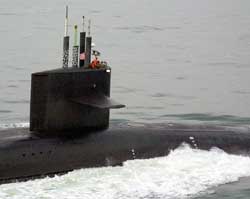
Official U.S. Navy file photo of USS Florida (SSBN 728). Florida recently took part in Giant Shadow, the first in a series of experiments overhauling and converting four Ohio-class ballistic missile submarines to guided-missle submarines.
The SSGN conversion program, spearheaded by NAVSEA, takes four SSBNs (Florida, USS Ohio (SSBN 726), USS Michigan (SSBN 727) and USS Georgia (SSBN 729)) selected for decommissioning and transforms them into new platforms with capabilities to fight in future conflicts.
“As a result of the Nuclear Posture Review, the President decided we needed 14, vice 18 Trident submarines,” said Capt. William Toti of Assistant Chief of Staff for Warfare Requirements for COMNAVSUBFOR and the Joint Force Maritime Component Commander for Giant Shadow. “We decided we could take the four SSBNs we were going to decommission and instead use them in this new capacity. It is truly transformational.”
The SSGNs will have the capability to support and launch up to 154 Tomahawk missiles, a significant increase in capacity as compared to other platforms. The 22 missile tubes will also provide the capability to carry other payloads, such as unmanned underwater vehicles (UUVs), unmanned aerial vehicles (UAVs) and special forces equipment.
This new platform will also have the capability to carry and support more than 66 Navy SEALs (Sea, Air and Land) and insert them clandestinely into potential conflict areas.
Giant Shadow explored how a network of forces, including Florida, special warfare forces, UUVs and UAVs, and various aerial, underwater and ground sensors could be used to provide surveillance, collect real-time intelligence, develop and recommend a course of action for the joint commander and launch a time-critical strike.
Elements of the experiment included an at-sea demonstration and validation launch of two Tomahawk missiles from Florida, the first-ever vertical launch of a UUV and an insertion of SEALs from Florida.
Giant Shadow also provided an opportunity to evaluate various technologies, such as nuclear-biological-chemical sensors, intelligence, surveillance and reconnaissance (ISR) and targeting systems.
“One of the goals of Giant Shadow is to identify which technologies provide real operational value to the warfighter, so we can transition them into real acquisition programs,” said Toti.
Several Navy commands participated in Giant Shadow. USNS Mary Sears (T-AGS-65), Naval Meteorology and Oceanography Command’s oceanographic survey ship, was home for the command and control capabilities that will be put aboard the SSGN as part of the conversion process. Naval Air Systems Command’s “Hairy Buffalo,” a modified P-3C Orion aircraft, provided ISR capability and communication networking that would normally be provided by a high-altitude UAV like Global Hawk. Naval Oceanographic Office provided their UUV, the “Sea Horse,” and elements of Naval Special Warfare Group Four supported the special warfare phases of the experiment.
Results of the experiment are still being evaluated.
“Today’s battlefield is vastly different than it was during the Cold War,” said Toti. “The SSGNs will provide an extremely powerful capability that can operate like a ghost – it’s out there, but you can’t see it – which will complicate the defense of anyone who wants to challenge the United States.”
The SSGN conversions, which will include engineered refueling overhauls (ERO), will take place at Norfolk Naval Shipyard and Puget Sound Naval Shipyard, Bremerton, Wash., which began with Ohio in November 2002. Florida’s ERO and conversion will begin in August.
The first SSGN is scheduled for delivery in 2007.
NAVAIR Patuxent River to Host Second UAV Flight Demonstration
PATUXENT RIVER, Md. (NNS) — The second demonstration of multiple unmanned aerial vehicle (UAV) systems has been officially set for July 14 at the Webster Field Annex of Naval Air Station Patuxent River.
The event will be sponsored by the Program Executive Office for Strike Weapons and Unmanned Aviation, in conjunction with the Association for Unmanned Vehicle Systems International (AUVSI). It will serve to kick off AUVSI’s annual conference at the Baltimore Convention Center.
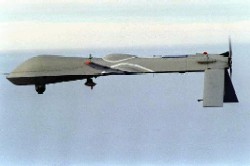
RQ1L Predator in flight. A UAV demonstration will be held July 14 at the Webster Field Annex of Naval Air Station Patuxent River. The demonstration will kick off the Association for Unmanned Vehicle Systems International's annual conference in Baltimore.
The 2001 inaugural event was attended by more than 2,400 guests, including 169 distinguished visitors from Capitol Hill, the Department of Defense and NATO embassies.
The flying participants represented many types of UAVs, including small/tactical, medium endurance, fixed wing and rotor wing vehicles. Event planners are expecting twice the number of UAV system demonstrations, further promoting UAV technology and capabilities.
The event will be open to conference exhibitors, attendees and specially-invited guests.
“I’m thrilled about the opportunity to host this unique event again,” said Rear Adm. Jack Chenevey, program executive officer for Strike Weapons and Unmanned Aviation. “As we see increased focus from DoD and congressional leadership in the area of unmanned aviation, this event provides an important glimpse into our future.”
The focus of the UAV demo is to highlight UAV technology and capabilities. This venue offers a unique opportunity to display and demonstrate full-scale UAV systems and hardware.
The integration of an opti-screen LED monitor will allow the audience to see the same imagery as the UAV operators while the vehicle is in flight. The demo will include static displays all day and feature flight demos from 10:00 a.m. to 4 p.m.
For information about how to participate in the event, visit the demo Web site at http://uav.navair.navy.mil.
For related news, visit the NAVAIR - Naval Air Systems Command Navy NewsStand page at www.news.navy.mil/local/navair.
Pilot Survives U-2 Crash, Recovery Continues
OSAN AIR BASE, South Korea (AFPN) — An Air Force U-2 Dragon Lady pilot ejected safely before his aircraft crashed Jan. 26 near Hwa Song city, south of Seoul.

U2 spy plane crashed. Pilot Survives.
The pilot was taken to the base hospital here where his was listed in stable condition. He is being treated for a back injury and is expected to recover fully. The pilot is assigned to the 5th Reconnaissance Squadron here.
Four local civilians on the ground were also injured in the crash, and property at the crash site was damaged.
Snow and freezing temperatures prevented cleanup efforts Jan. 27, but base officials are hopeful that recovery will be completed by Jan. 28.
A board of officers will investigate the cause of the crash.
| Send Us News | Archives | Main |